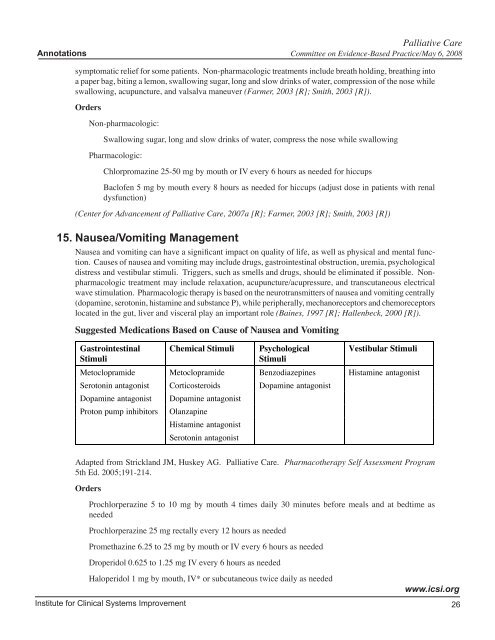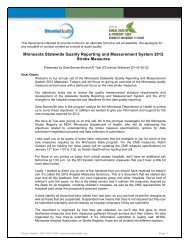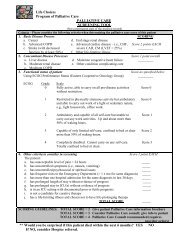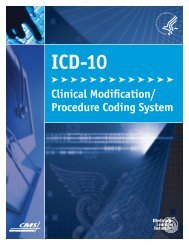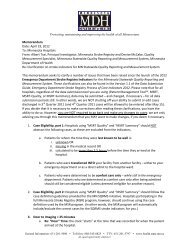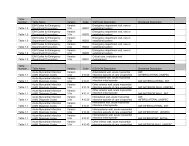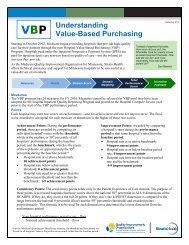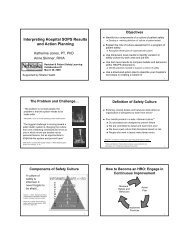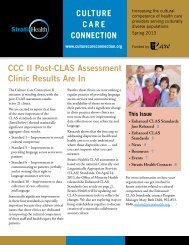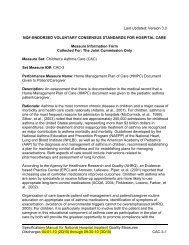Palliative Care Order Set - Stratis Health
Palliative Care Order Set - Stratis Health
Palliative Care Order Set - Stratis Health
Create successful ePaper yourself
Turn your PDF publications into a flip-book with our unique Google optimized e-Paper software.
<strong>Palliative</strong> <strong>Care</strong><br />
Annotations Committee on Evidence-Based Practice/May 6, 2008<br />
symptomatic relief for some patients. Non-pharmacologic treatments include breath holding, breathing into<br />
a paper bag, biting a lemon, swallowing sugar, long and slow drinks of water, compression of the nose while<br />
swallowing, acupuncture, and valsalva maneuver (Farmer, 2003 [R]; Smith, 2003 [R]).<br />
<strong>Order</strong>s<br />
Non-pharmacologic:<br />
Swallowing sugar, long and slow drinks of water, compress the nose while swallowing<br />
Pharmacologic:<br />
Chlorpromazine 25-50 mg by mouth or IV every 6 hours as needed for hiccups<br />
Baclofen 5 mg by mouth every 8 hours as needed for hiccups (adjust dose in patients with renal<br />
dysfunction)<br />
(Center for Advancement of <strong>Palliative</strong> <strong>Care</strong>, 2007a [R]; Farmer, 2003 [R]; Smith, 2003 [R])<br />
15. Nausea/Vomiting Management<br />
Nausea and vomiting can have a significant impact on quality of life, as well as physical and mental function.<br />
Causes of nausea and vomiting may include drugs, gastrointestinal obstruction, uremia, psychological<br />
distress and vestibular stimuli. Triggers, such as smells and drugs, should be eliminated if possible. Nonpharmacologic<br />
treatment may include relaxation, acupuncture/acupressure, and transcutaneous electrical<br />
wave stimulation. Pharmacologic therapy is based on the neurotransmitters of nausea and vomiting centrally<br />
(dopamine, serotonin, histamine and substance P), while peripherally, mechanoreceptors and chemoreceptors<br />
located in the gut, liver and visceral play an important role (Baines, 1997 [R]; Hallenbeck, 2000 [R]).<br />
Suggested Medications Based on Cause of Nausea and Vomiting<br />
Gastrointestinal<br />
Stimuli<br />
Chemical Stimuli<br />
Psychological<br />
Stimuli<br />
Vestibular Stimuli<br />
Metoclopramide Metoclopramide Benzodiazepines Histamine antagonist<br />
Serotonin antagonist Corticosteroids Dopamine antagonist<br />
Dopamine antagonist Dopamine antagonist<br />
Proton pump inhibitors Olanzapine<br />
Histamine antagonist<br />
Serotonin antagonist<br />
Adapted from Strickland JM, Huskey AG. <strong>Palliative</strong> <strong>Care</strong>. Pharmacotherapy Self Assessment Program<br />
5th Ed. 2005;191-214.<br />
<strong>Order</strong>s<br />
Prochlorperazine 5 to 10 mg by mouth 4 times daily 30 minutes before meals and at bedtime as<br />
needed<br />
Prochlorperazine 25 mg rectally every 12 hours as needed<br />
Promethazine 6.25 to 25 mg by mouth or IV every 6 hours as needed<br />
Droperidol 0.625 to 1.25 mg IV every 6 hours as needed<br />
Haloperidol 1 mg by mouth, IV* or subcutaneous twice daily as needed<br />
Institute for Clinical Systems Improvement<br />
www.icsi.org<br />
26


